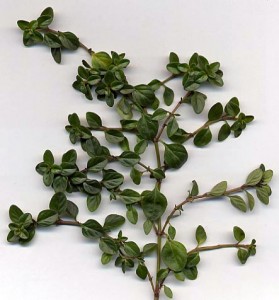“T” is for Thyme
Posted in Gardening Tips on July 15 2014, by Sonia Uyterhoeven
Sonia Uyterhoeven is the NYBG’s Gardener for Public Education.

The word “thyme” is derived from two possible Greek sources. One term means “to fumigate”—in ancient Greece, thyme was burnt at temples as incense, owing to its nice balsam odor. The other possible source is an association with courage. This association lasted from ancient Greece through the Middle Ages, when women gave knights gifts embroidered or decorated with thyme to inspire bravery.
These days, thyme—with its aromatic oils–is usually associated with invigoration. It is an asset in any landscape and makes a wonderful woody ground cover or a lawn alternative, as it is now commonly known. The diminutive pale pink or lavender flowers are a magnet for bees and help them to produce a wonderful honey. A large industry exists for extracting the herb’s essential oils. These oils are primarily distilled in the South of France, where the arid climate suits the plant’s Mediterranean temperament perfectly.
Some varieties of thyme have their place in the kitchen while others are more suited for the landscape. The most popular thyme is English thyme (Thymus vulgaris). English thyme is not native to England—the Romans introduced the herb—but the Brits took it on as their own. It has the strong, distinctive flavor that we most associate with the herb today.
